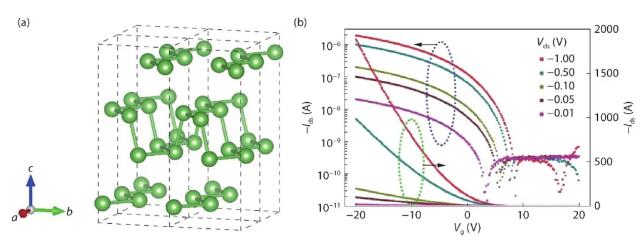专家视点 | 何军教授:一种新型的单元素层状二维半导体—黑砷 [2020-08-25] |
| 一种新型的单元素层状二维半导体—黑砷 厚度为原子层的二维层状材料体系,由于其新奇的物理性质、极具竞争优势的输运性能,被认为是延续摩尔定律的方案之一。第一种二维材料—石墨烯,被发现之后,涌现了大量的二维材料,如MX2(M = Ga,Mo,W,Re,Hf,V;X = S, Se, Te)、InSe、 b-P等等;但是截至目前,能够同时兼具高载流子迁移率、合适能带结构、优异环境稳定性的二维材料仍有待进一步发掘。
近日,中南大学物理与电子学院何军教授团队在《Journal of Semiconductors》上撰写news and views文章《A new single-element layered two-dimensional semiconductor: black arsenic》,简要介绍了一种新型的单元素二维层状半导体黑砷在基本物性及光电器件应用方面的研究进展,并对目前所存在的问题进行了讨论。
常见砷的同素异形体有三种,灰砷、黄砷、黑砷,其中黑砷为半导体并能稳定存在于自然界,理论预测黑砷具有超过(5.29-12.32) ´ 103 cm2V-1s-1的载流子迁移率,同时其具有极大的热、电输运各向异性,在高速光电器件中具有重要的应用潜力。最近我们的实验发现黑砷具有优异的场效应特性及好的环境稳定性(Adv Mater, 2018, 30, 1800754;Adv Funct Mater, 2018, 28, 1802581),但是黑砷的研究仍然面临一些问题,如怎样实现与理论值相当的载流子迁移率、如何从实验上生长高质量的黑砷晶体、如何进一步提高晶体的环境稳定性。我们相信,随着研究的不断深入,所有的这些问题都会被很好的解决,同时更多新奇的物理性质将被发现。 Full Text The discovery of graphene, the first two-dimensional material with a thickness of an atomic layer, opened the prelude to the development of other atom-thin two-dimensional layered materials. They are considered to be one of the best candidates to extend Moore’s law. However, graphene is a zero-bandgap semimetal, which limits its application in logic circuits[1]. In 2014, Zhang’s group from Fudan University reported a new type of elemental 2D material — black phosphorus (b-P) with an adjustable bandgap of ~0.34 to ~2 eV. In addition, few-layer b-P exhibits high carrier mobility about 1000 cm2V–1s–1 and large on–off current ratio >105[2]. It makes possible to achieve the application of 2D materials in logic integrated. However, as research continued, scientists discovered that b-P is quite unstable under atmospheric environments. The few-layer b-P crystals can be seriously degraded within a few minutes, which directly limits its applications in optoelectronic devices[3]. In contrast to b-P, another group-VA element crystal, arsenic, also has the layered structure. Arsenic usually has three allotropes in nature: gray arsenic, yellow arsenic and black arsenic (b-As). Among them, the most stable and common crystalline state is gray arsenic, which has a double-layer structure composed of interlocking six-membered rings similar to blue phosphorus, and it has a metallic electronic structure. The yellow arsenic is an insulator and has a similar crystal structure of white phosphorus. In contrast, there are limited studies on b-As. B-As, like b-P, has an orthorhombic structure with a layered configuration (ε-As, space group Bmab). Inside a single layer, each arsenic atom is covalently bonded with three adjacent atoms to form a puckered honeycomb network, and the adjacent layers are held together by weak van der Waals interactions (Fig. 1(a))[4, 5]. Recent theoretical studies predicted that it has good stability and extraordinary physical properties. In 2015, Zeng’s group of Nanjing University of Science and Technology predicted that the atomically thin arsenene is thermodynamically stable, and it has a wide electronic bandgap and an ultra-high carrier mobility through first-principle calculations[6]. After that, several groups also carried out the theoretical studies on their physical properties in detail[7-10]. According to the results, the bandgap of b-As has a strong layer number dependence. The bulk b-As has a direct bandgap of about 0.3 eV. With the number of layers gradually decreases, the bandgap gradually increases; when the thickness decreases to two-layers, it is still a direct band gap. However, when the thickness continues to decrease to single layer, it changes into an indirect band gap semiconductor, and the calculated band gap value of the monolayer b-As is about 0.73–1.403 eV. This uncertainty of the bandgap is mainly derived from the adopted differences in calculation methods and differences in modelling. More interestingly, the theoretical studies predicted that the carrier mobility of b-As can reach (5.29–12.32) × 103 cm2V–1s–1; meanwhile, the conductance and carrier mobility have obvious anisotropy in the direction of the armchair and the zigzag directions[11].
Figure 1. (Color online) (a) 3D crystal structures of b-As. (b) Transfer characteristics (Ids–Vg) of the monolayer b-As FET[5]. Copyright 2018 John Wiley and Sons. More recently, several groups have experimentally studied the properties of arsenic crystals with different structures. Tsai et al. successfully synthesized the multilayer gray arsenic with a rhombohedral structure on InAs substrate using the plasma-assisted process[12]. Chen et al. rediscovered the b-As crystals from a natural mineral, and studied its physical properties[4]. The electronic structure of the bulk b-As crystal was measured by the Nano-ARPES. They found that the conductance, carrier mobility, and thermal conductivity of the bulk b-As possesses high anisotropies along AC and ZZ directions. To further explore the application of b-As in electronics and optoelectronics, Zhong et al. successfully synthesized the monolayer and few-layer b-As crystals by the traditional micromechanical exfoliation method[5]. The properties of few-layer b-As based field-effect transistors show strong thickness dependence. The obtained highest carrier mobility up to about 59 cm2V–1s–1 and the largest current on/off ratio exceeding 105 (Fig. 1(b)). More important, few-layer b-As crystals show a relatively good ambient stability: the few-layer b-As based FET still can work after exposure in air conditions for about one month. Research on b-As crystals is in the primary stage, and they still face many problems that need to be solved. How to achieve the carrier mobility from experimentally close to the theoretical value? How to improve the environmental stability of crystals? Can we find a suitable method to achieve controllable synthesis of few-layer b-As? All of these issues are obstacles to the development of b-As crystals. We believe that with the deepening of research, all these problems will be solved. B-As crystal will become an important candidate for multi-functional applications in nanoelectronic devices. References: [1]Schwierz F. Graphene transistors. Nat Nanotechnol, 2010, 5, 487 [2]Li L, Yu Y, Ye G J, et al. Black phosphorus field-effect transistors. Nat Nanotechnol, 2014, 9, 372 [3]Island J O, Steele G A, van der Zant H S, et al. Environmental instability of few-layer black phosphorus. 2D Mater, 2015, 2, 011002 [4]Chen Y, Chen C, Kealhofer R, et al. Black arsenic: a layered semiconductor with extreme in-plane anisotropy. Adv Mater, 2018, 30, 1800754 [5]Zhong M, Xia Q, Pan L, et al. Thickness-dependent carrier transport characteristics of a new 2D elemental semiconductor: black arsenic. Adv Funct Mater, 2018, 28, 1802581 [6]Zhang S, Yan Z, Li Y, et al. Atomically thin arsenene and antimonene: semimetal–semiconductor and indirect–direct band-gap transitions. Angew Chem Int Ed, 2015, 54, 3112 [7]Kou L, Ma Y, Tan X, et al. Structural and electronic properties of layered arsenic and antimony arsenide. J Phys Chem C, 2015, 119, 6918 [8]Kamal C, Ezawa M. Arsenene: Two-dimensional buckled and puckered honeycomb arsenic systems. Phys Rev B, 2015, 91, 085423 [9]Luo K, Chen S, Duan C. Indirect-direct band gap transition of two-dimensional arsenic layered semiconductors — cousins of black phosphorus. Sci China Phys, Mechan Astron, 2015, 58, 1 [10]Wang C, Xia Q, Nie Y, et al. Strain engineering band gap, effective mass and anisotropic Dirac-like cone in monolayer arsenene. AIP Adv, 2016, 6, 035204 [11]Zhang Z, Xie J, Yang D, et al. Manifestation of unexpected semiconducting properties in few-layer orthorhombic arsenene. Appl Phys Express, 2015, 8, 055201 [12]Tsai H S, Wang S W, Hsiao C H, et al. Direct synthesis and practical bandgap estimation of multilayer arsenene nanoribbons. Chem Mater, 2016, 28, 425
芙蓉学者特聘教授,国家优秀青年科学基金获得者。中南大学本科生院院长,湖南省超微结构与超快过程重点实验室副主任。吉林大学理学学士、硕士,新加坡国立大学理学博士。先后在新加坡国立大学、美国纽约城市大学、加拿大多伦多大学从事研究工作。2009年评为中南大学教授,2010年聘为中南大学升华学者,2011年入选教育部新世纪优秀人才,2012年获得国家优秀青年科学基金、湖南省杰出青年科学基金,2015年入选湖南省芙蓉学者特聘教授。 研究领域为超快非线性光学、半导体自旋电子学、类石墨烯二维材料与器件。主持国家自然科学基金项目 3 项、省部级项目 4 项。在以Phys. Rev. Lett.、Nano Lett.、Adv. Mater.为代表的国际期刊发表 SCI 论文 160余篇,其中高被引论文7篇(含热点论文4篇),SCI引用2900 余次,h-index 29。在国际上首次提出并验证了半导体纳米结构电荷空间分离可以调控电子或空穴自旋弛豫速率的概念。在半导体量子点多光子吸收领域的研究工作被美国科学网站 PhysOrg.com 专题报导。近年来在二维材料超快非线性光学效应、飞秒激光制备纳米条纹结构、二维材料神经形态晶体管研究中取得重要进展。 点击阅读何军教授文章: A new single-element layered two-dimensional semiconductor: black arsenic Mianzeng Zhong, Jun He J. Semicond. 2020, 41(8): 080402 doi: 10.1088/1674-4926/41/8/080402 《半导体学报》简介: 《半导体学报》是中国科学院主管、中国电子学会和中国科学院半导体研究所主办的学术刊物,1980年创刊,首任主编是王守武院士,黄昆先生撰写了创刊号首篇论文,2009年改为全英文月刊Journal of Semiconductors(简称JOS),同年开始与IOPP英国物理学会出版社合作向全球发行。现任主编是中科院副院长、国科大校长李树深院士。 2016年,JOS被ESCI收录。 2019年,JOS入选“中国科技期刊卓越行动计划”。 “中国半导体十大研究进展”推荐与评选工作简介: 《半导体学报》在创刊四十年之际,启动实施 “中国半导体年度十大研究进展”的推荐和评选工作,记录我国半导体科学与技术研究领域的标志性成果。以我国科研院所、高校和企业等机构为第一署名单位,本年度公开发表的半导体领域研究成果均可参与评选。请推荐人或自荐人将研究成果的PDF文件发送至《半导体学报》电子邮箱:jos@semi.ac.cn,并附简要推荐理由。被推荐人须提供500字左右工作简介,阐述研究成果的学术价值和应用前景。年度十大研究进展将由评审专家委员会从候选推荐成果中投票产生,并于下一年度春节前公布。 JOSarXiv预发布平台简介: 半导体科技发展迅猛,科技论文产出数量逐年增加。JOSarXiv致力于为国内外半导体领域科研人员提供中英文科技论文免费发布和获取的平台,保障优秀科研成果首发权的认定,促进更大范围的学术交流。JOSarXiv由《半导体学报》主编李树深院士倡导建立,编辑部负责运行和管理,是国内外第一个专属半导体科技领域的论文预发布平台,提供预印本论文存缴、检索、发布和交流共享服务。 JOSarXiv于2020年1月1日正式上线(http://arxiv.jos.ac.cn/),通过《半导体学报》官网(http://www.jos.ac.cn/)亦可访问。敬请关注和投稿!
半导体学报公众号 微信号 : JournalOfSemicond 长按二维码关注获得更多信息 |
首 页 >> 通知公告








